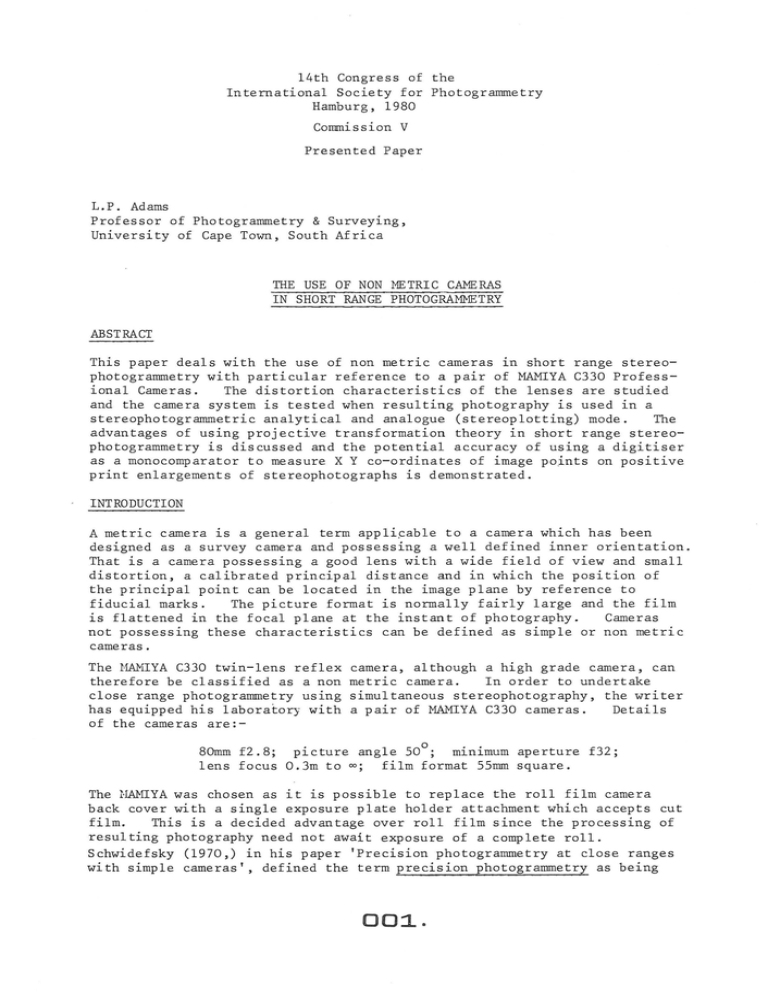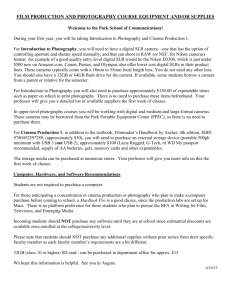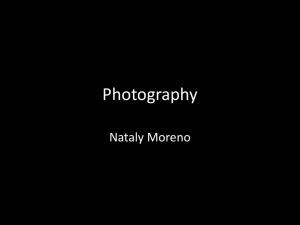14th Congress of the Hamburg, 1980
advertisement

14th Congress of the International Society for Photogrammetry Hamburg, 1980 Commission V Presented Paper L.P . Adams Professor of Photogrammetry & Surveying, University of Cape Town , South Africa THE USE OF NON 11ETRIC CA11ERAS IN SHORT RANGE PHOTOGRA:MJvlETRY ABSTRACT This paper deals with the use of non metric cameras in short range stereophotogrammetry with particular reference to a pair of MAMIYA C330 Professional Cameras . The distortion characteristics of the lenses are studied and the camera system is tested when resulting photography is used in a stereophotogrammetric analytical and analogue (stereoplotting) mode. The advantages of using projective transformation theory in short range stereophotogrammetry is discussed and the potential accuracy of using a digitiser as a monocomparator to measure X Y co-ordinates of image po_ints on positive print enlargements of stereophotographs is demonstrated . INTRODUCTION A metric camera is a general term appli .c able to a camera which has been designed as a survey camera and possessing a well defined inner orientation . That is a camera possessing a good lens with a wide field of view and small distortion, a calibrated principal distance and in which the position of the principal point can be located in the image plane by reference to fiducial marks. The picture format is normally fairly large and the film is flattened in the focal plane at the instant of photography. Cameras not possessing these characteristics can be defined as simple or non metric cameras. The HMHYA C330 twin-lens reflex therefore be classified as a non close range photogrammetry using has equipped his laboratory with of the cameras are:- camera, although a high grade camera, can metric camera. In order to undertake simultaneous stereophotography, the writer a pair of MAMIYA C330 cameras . Details 80mm f2 . 8; picture angle 50° ; minimum aperture f32; lens focus 0.3m to oo; film format 55mm square. The HAHIYA was chosen as it is possible to replace the roll film camera back cover with a single exposure plate holder attachment which accepts cut film. This is a decided advantage over roll film since the processing of resulting photography need not await exposure of a complete roll . Schwidefsky (1970,) in his paper 'Precision photogrammetry at close ranges with simple cameras', defined the term precision photogrammetry as being 00:1. when the relative mean square error of the distances from the camera lies between 1/lOOOth and 1/lOOOOth of the distances . With this definition ln mind a number of empirical laboratory tests were undertaken using the MAMIYA non metric cameras . LENS DISTORTION It is generally believed by photogrammetrists that, besides the imaging errors produced by the lack of flatness of the film, the distortions produced by the comparatively simple lenses normally associated with non metric cameras are so large as to preclude the use of such cameras in precision short range photogrammetry . In the MAMIYA cameras tested the cut film is held against the focal plane edges by a pressure plate but the film is not strictly flat in the accepted sense and "flatness" is dependant on the rigidity of the cut film . Little can be done to remedy the problem, if indeed it is a problem . Much has been written about the definition of lens distortion and the means of measuring the effect. The writer favours Thompson (1977) in his con,tention that the significant feature of distortion is the test of whether or not a straight line projects as a straight line . In this test an accurate lOcm grid was photographed at a distance of approximately l . Sm . XY co- ordinates of grid intersections were then measured on the resulting negative using a STEKO 1818 stereocomparator used in a mono comparator mode . Deviations from the straight line in the X and Y directions were calculated and the vector displacements from the true grid intersections were plotted . Points were then joined by smooth curves in the X andY direction (Fig . l) . The resulting graph shows a classical "barrel " type distortion . MAMIYA CAMERA LENS NO 690726 DISTORTION CHARACTERISTICS F ig 1 002. Of more quantitative significance is the distortion contour plan (Fig . 2) which shows that, provided the format corners are avoided, image displacements on the plate will not be in excess of 40 ~m . Both cameras were tested and the resulting graphs indicated that distortion characteristics of both lenses were remarkably similar. MAMIYA CAMERA LENS NO. 890726 DISTORTION CONTOUR PLAN VERTICAL INTERVAL 5 MICRONS FILM FORMAT Fig 2 The magnitude of image displacement will vary with the principal distance but on the whole the lenses can be considered as being of good quality and potentially capable of producing results within the definition of precision photogrammetry. The next step in the empirical testing process is to establish the accuracy with which space points can be fixed when the cameras are used in a stereoscopic mode. This involves either an analytical or an analogue (stereoplotter) process. ESTABLISHMENT OF CALIBRATION FIELD In order to determine the inner orientation elements of the camera and to undertake empirical accuracy tests a calibration field was designed comprising 80 accurately co-ordinated targets in four planes approximately 0.9 metres apart . The targets consist of small brass discs onto which black and white concentric circles are embossed . This type of target has been found to be very satisfactory for high precision comparator observations. The rear plane targets are attached to the room wall and the remaining targets attached to steel rods which are constrained to hang truly 003. vertically without rotating around the vertical axis (See Fig.J). The control targets were co- ordinated in three dimensions using horizontal and vertical circle reading obtained from theodolite observations in which the theodolite was mounted on three separated and precisely co-ordinated metal tripods attached to the floor of the room . The free net control values of the targets were then derived as an exercise in three dimensional intersection with an estimated m. s . e . of ± 0 . 4mms . For all practical purposes the control can therefore be assumed to be error free. Fig . 3 The photograph shows the calibration field and includes the pair of }WililYA cameras mounted on the camera base bar and attached to a metal tripod for parallel photography STEREOPHOTOGRAPHY The accuracy tests comprised analytical and analogue (stereoplotting) methods. For the purpose of the stereoplotter tests it was necessary to undertake nominally parallel stereophotography but for the analytical tests , as well as parallel photography, convergent photography can also be used . In the event for parallel ray photography the two cameras were mounted on a bar at a separation distance of approximately 0 . 9 metres and for conver gent stereophotography the cameras were mounted on the outer two metal tripods witl 1 a separati on distance of approximately 3 . 3 metres . The avera ge distance to the targets from the camera stations was approximately 5 metres . To utilise photog raphy in a stereoplotter it is necessary to determine the elements o f inner orientation for each e xposure, i . e . the principal distance and position of the prin c ipal point must be established in order to create and correctly scale the st e reomodel in the plott i ng instrument. If it is only required to analytically determine space co- orcinates and image points using a pair of pictures then provided a minimum of six suitably distributed free net control points e x ists within the object space and are imaged in the picture plane then by the use of projective transformations and using homogeneous co - ordinates and collinearity equations it is possible to calculate the three dimensional co - ordinates of common image points in terms of the free net control system . The theory and mathematical te chniques employed in this somewhat complex projective geometry problem has b e en discussed in a previous paper (Adams 1979) . For ease of reference the appropriate formulae are summarised below : Calculati on of Transformation Parameters x. (l) y. (2) ~ ~ where X., Y. , Z. are free net spa c e co-ordinates of point P. ~ ~ ~ ~ x ., y . a re compar a tor im a ge co - o r dinates of point P . ~ ~ ~ referred to an arbitrary origin , b .. are transformation parameters . ~J Calculation of s2a ce Co- ordinates us~ng Stereo2air (x. b 31- b11) X. + (x . b 32 - bl2)Y . + (x.b 3 3- b l3 )Z.+ x . - bl4 ~ ~ ~ ~ ~ ~ ~ 0 (y.b 3 1- b2l)X.+ (y . b32 - b22)Y . + (y.b33 - b2 3)Z .t y .- b24 ~ ~ ~ ~ ~ ~ ~ 0, ex . b31 - iJ"ll)X.+ cx.'b32- bl2)Y.+ ex . b3r bl 3)Z . + x .- bi:"4 ~ ~ ~ ~ ~ ~ ~ 0, (y.~- b 2 l)X . + (Y . b32- b 22 )Y . + (y.b 33 - b 23 )Z .+ y .- b 2 4 ~ ~ ~ ~ ~ ~ ~ 0 ' (3) where the unbarred elements refer to the left hand picture and the barred elements to the right hand picture . It will be noted that the traditional elements of inner and relative orientation are not apparent , but these can be obtained from a knowledge of the b . . elements if so desired . ~J Summarised , the appropriate ~nner orientation equations are : DOS. Non- zero scalar A! (4) Principal point co- ordinates (comparator system) : (b 11 b 31 + b 12 b 32 + b 13 b 3 3)A 2 (5) Cb21h31+ h22h32+ h23b33)A 2 (6) Equiva}ent principal distance : (7) 2 + b222 + b23 3) A'2 - y2p (b 21 Use average of c X and c . y Unless it is intended to plot from the stereopair using a stereoplotter, the inner orientation elements are of academic interest only and therefore only equations (l), (2) and (3) are relevant . ACCURACY TESTS (a) Analytical Tests Progress in the application of short-range photogrammetric measurement techniques by the engineering and other non technical disciplines is hampered due to the specialist expertise required to operate stereoplotters and to the very high cost of stereophotogrammetric and ancillary equipment associated with a photogrammetric laboratory . Any attempt to move away from the traditional highly sophisticated and expensive map making process associated with aerial photogrammetry is therefore to be welcomed and in the best interest of short range photogrammetry . These possibilities now exist since the mini computer with its associated periphereals such as X Y plotters and digitiser tables are nowadays commonplace and comparatively inexpensive . The digitiser is in effect a comparator and the X Y plotter has limited stereoplotter capability . The resolution of the normal digitiser is , in the photogrammetric sense, coarse but the use of much enlarged stereophotographic paper prints effectively increases the resolution in terms of the original negative plate produced by a small format simple camera . Significant results were achieved using this type of equipment for the measu r ement of X ray picture pairs (Adams 1980) and the technique has been extended to this exercise . }~asurements of X Y co- ordinates of 50 common targeted points were made on the original negative pairs of the convergent photography in the stereocomparator (resolution 5 ~m) and on paper prints of the pair (4 times enlargement) using a Summagraphics ID- 2- ll/48 digitiser (resolution O,lmm) attached to a Tektronix 4051 graphic system. Combinations of and the number of control points selected to derive the 006. projective transformation parameters varied from the minimum (6 points) up to 34 points, and the accuracy of 3 dimensional fixation was gauged from a comparison of control target free net values with the calculated values . A sample of the results obtained follows :- SUMMARY OF RESULTS- CONVERGENT PHOTOGRAPHY NO. OF CONTRO f'D . (mms) POINTS USED IN LEFT f'P RIGHT COORD ., (mmsl L FT X" ABSOLUTE y X AVERAGE / RIGHT DISPLACEMENT (50 POI/'ITS) y ox OY Dl ACCURACY VECTOfi COMPARAIDR 34 83.61 84 45 25.52 21 .59 88 .87 22 .02 0 . 76 0 58 1.88 2.11 83.41 84 .02 25.69 21.72 8901 21.78 0 97 oJ- 1' 2350 10 2 36 2 67 1' 1900 6 82.37 84 .47 l5 59 20 73 89 .85 22.04 1.41 1. 85 3 .25 4.00 1' 1250 DIGITlSER (ENLARGEMENT OF PRINT 4 14) 34 345.54 351 .61 1. 14 1.25 2.75 3.23 1 ' 1550 10 343. 57 349.42 1.74 2.25 3.29 4 .35 1>1150 6 347.78 348.23 1.51 1.52 5.24 5 .66 1 , 9QO As was to be expected the stereo comparator observed pairs give the best results but these are only marginally better than the digitiser results. (b) Analogue (stereoplotter) tests Since the film format (S . Scm square) is too small to permit the carry~ng out of an effective empirical relative orientation procedure on a normal stereoplotter (in this case a Zeiss Jena Topocart stereoplotter was used) enlarged paper prints (4 times) were made of the parallel photography giving an approximate equivalent to a 23 x 23cm air photograph . For stereoplotting purposes it was necessary to locate the principal points and to determine the equivalent principal distances of the paper print pair . This was undertaken by attaching the prints to the digitiser and calculating these parameters using equations 5, 6 and 7 . The positions of the principal points were then located and marked directly by reference to a display of co- ordinates on the mini computer graphic display screen and the movement of the digitiser cursor over the picture print until the correct co- ordinates were displayed . In the event the equivalent principal distances of the prints were beyond the limits of the stereoplotter but the problem was solved by halving the principal distance and accommodating the resulting differential Z by doubling the model scale for the purpose of selecting the Z gear ratio . A normal empirical relative and absolute orientation was carried out and convergency height error was adjusted by use of an equal and unlike ~ tilt . The necessity of applying a convergency correction in short range stereophotogrammetry when large Z differences are present and when photography is processed in a stereoplotter cannot be over emphasised (Adams 1978) . The negatives of the parallel photography were also processed as an exercise in projective transformation as described above using 34 common 007. control points to determine the transformation parameters. of the analytical and stereoplotter tests uere:- The results SUMMARY OF RESULTS - PARALLEL PHOTOGRAPHY CAMERA BASE 0 .922 M COMPARATOR NO. OF CONTROL P D (mms J POINTS USED IN LEFT RIGHT RAN SFORMATkJN 34 8 4 .20 STEREO PLOTTER PD. 84 90 ABSOLUT E AVERAGE DISPLACEMENTS (4 6 POINTS ) ACCURACY DX DY Dl VECIDR 0 .70 0 74 4 .75 4 86 I 1050 ( PAPER PRINT S 4 TIMES ENLARGEMENT ) LEFT·348mm s RIGHT - 35 2 mms ABSOLUTE AVERAGE DISPLACEMENT IN i! ( 38POINTS ) =3.6mms HEIGHT ACCURACY = 1, 1500 CONCLUSIONS The results of these tests show that the MAMIYA C330 camera fulfils the specified requirements of precision photogrammetry both in the analogue and analytical mode . Further tests are being undertaken in the writer's laboratory and in the field using other types of simple cameras . The study has also been extended to the close range survey of underwater structures using underwater cameras. Preliminary results are very encouraging and the studies merit further investigation particularly in the use of non-metric cameras for providing much enlarged stereo pictures of engineering works etc . for processing on mini computers operating on digitised data . REFERENCES Adams , L . P. , 1978 The use of a non metric camera for very short range dental stereophotogrammetry. Photogrammetric Record, 9 (51) : 405-414 Adams, L . P . , 1979 An experiment with anal y tical shadow stereophotogrammetry. Ibid., 9(54): 835-8 47 Adams , L . P . , 1980 The use of short range stereophotogrammetry Ln the study of the morphology of the shoebill bill . Ibid . , 10 (55): Schwidefsky, K. , 1970 Precision photogrammetry at close ranges with simple cameras . Ibid . , 6(36) : 567-589 Thompson, E. H. , 1977 A note on distortion . oooOooo 008. Ibid., 9(49): 93-99





